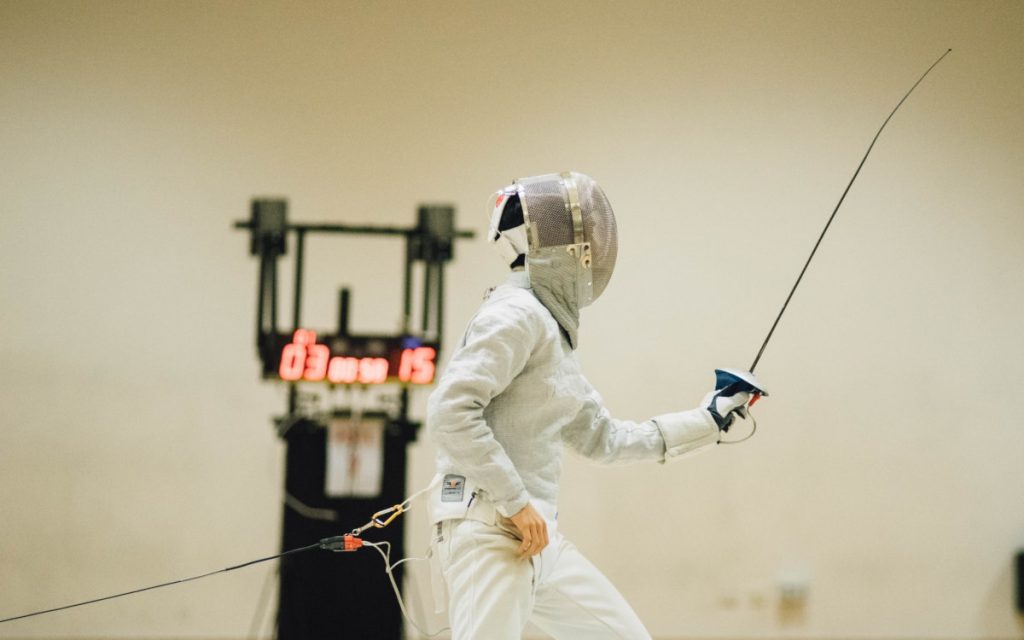Fencing in a broader term could be said to include various combat sports where swords and other melee weapons are used. It can of course be debated what can be called fencing and not. E.g. historical fencing is, but not all swordsmanship is. Here we will however be liberal and inclusive and so cover various types of fencing, swordsmanship and activities alike.
Sport Fencing

Sport fencing, a.k.a. modern fencing or olympic fencing, is a sport with it’s origins based in swordsmanship. When referring to fencing, this is what people usually referrs to. It has been part of the Olympic Games since they started and it can be considered quite a competitive sport and many of it’s practitioners compete more or less regularly.
Weapons
There are three different swords/weapons in sport fencing:
- Foil – A lighter weapon for thrusts only. The only valid target is the torso, not the head, arms or legs. Special rules of who has the ”right of way” decides who gets a point in case of simultaneous hits. Simplified one can say that the the one who is attacking (or counter attacking) has the right of way.
- Épée – A heavier weapon for thrusting only. The entire body is a valid target, from the toes to the top of the head. No special ”right of way” rules apply and the one hitting first gets the hit.
- Sabre – A lighter weapon for both cuts and thrusts. The valid target is from the waist and up, except the hands. As in foil a ”right of way” rule is used to decides who gets a point in case of simultaneous hits.
Historical Fencing
Work in progress.
Historical Medieval Battles – HMB
Work in progress.
Kendo and Kenjutsu
Work in progress.
Kendo is Japanese sport, originating from Japanese swordsmanship, Kenjutsu. It is a widely spread fencing sport using bamboo swords, called shinai. Kendo is however not just about fencing, but a highly traditional, disciplined and educational sport and kendo has it’s defined concept:
- The concept of kendo is to discipline the human character through the application of the principles of the katana (sword).
And the purpose of practicing Kendo is:
- To mold the mind and body
- To cultivate a vigorous spirit
- And through correct and rigid training
- To strive for improvement in the art of Kendo
- To hold in esteem human courtesy and honor
- To associate with others with sincerity
- And to forever pursue the cultivation of oneself
This will make one be able:
- To love his/her country and society
- To contribute to the development of culture
- And to promote peace and prosperity among all peoples
So while still being a fencing sport, both for training and competitions, it is more than that. Kind of a way of life if you will, aiming for self-development and thereby contributing to the the society and fellow human beings.
Kenjutsu – Japanese Swordsmanship
Kenjutsu is the name for all Japanese swordsmanship, originating from the martial arts of the Samurais in feudal Japan. It is often performed without an (independent active) opponent, focusing on the movement together with the sword, performing a kata. But it can also include sparring with wooden or bamboo swords, or even metal swords, and proper protection. Within Kenjutsu there is also the art of cutting with sharp swords on test targets, Tameshigiri.
Wushu and Chinese swordsmanship
Work in progress. Image to be added.
There’s no Chinese martial art purely focusing on fencing or swordsmanship, comparing e.g. Kendo in Japan. The Chinese swordsmanship is included within the Chinese martial arts, known as Kung fu or Wushu. Wushu’s origins dates back thousands of years and includes hundreds of fighting styles.
There are several swords and weapons used within Wushu. The martial arts are rarely sparring and fencing oriented though, but more focused on the handling of the weapons and competitions with weapons are then often an assessment sport.
The most common swords used within Chinese swordsmanship are:
- Dao – A single-edged sword, most often curved. Primarily made for cutting, but can also be used for thrusting.
- Jian – Double-edged straight sword, designed for cutting and thrusting.
Comparing different types of fencing and swordsmanships
Work in progress. Comparison chart to be added.
Here is a comparison chart of different types of fencing and sword combat practices, as practiced today.
